Topics Covered in this Section
10.1 Unit Objectives and Textbooks
10.2 An Introduction to the Biodiversity Crisis
10.3 The Ecological Context of the Current Mass Extinction
10.4 Characteristics of Small Populations
10.5 Management Tools for Endangered Species Recovery
10.6 A Few Tools for Population Performance
10.7 A Case Study in Game Species Management - Trinidad and Tobago
AGLS 6502 Lecture 10 - Management of Scarce and Declining Wildlife
[Endangered Species]
10.1 Unit Objectives and Textbooks
Objectives
- When is wildlife too scarce (Endangered Species)
- The subject Defined
- Rationale for Saving
- Causes of Extinction
- Genetics of Small Populations
- The Endangered Species Act
- Section 7
- Cooperation Action
- The International Component
- The Listing Process
- Species
- Habitat
- Consultation
- Recovery Plan
- Candidate Species
- Management
- Habitat
- Captive Breeding
- Double Clutching
- Cross Fostering
- Zoos
- Surrogate Species
- Habitat Acquisition
- International Programs
- Biological Verses Political Considerations
- Species Descriptions
- Increasing population size through the manipulation of birth, death & recruitment
- Special Challenges posed by endangered species.
Textbooks
Anderson (1991) Chapter 21
back to top10.2 An Introduction to the Biodiversity Crisis
What are Endangered Species?
An endangered species is a species whose population has been so reduced as to make the species susceptible extinction in the near future (through environmental, demographic or genetic stochasticity).
Why has Endangered Species Management become so important?
- Loss of biological components of value to humans:
- Consumptive Use Values
- Environmental Goods (eg. food, medicines)
- Non-consumptive Use values Climate control
- Oxygen recharge
- Option values
- Existence values
- Bequest Values
What is Biodiversity?
Genetic diversity:
- The number of genes that have more than one allele (polymorphic genes)
- Number of alleles for each gene (heterozygosity)
Species diversity:
Definitions of what a species is:
- Biological species concept
- Based on reproductive isolation.
Number of Species described: 1.8 million
Estimated of Number of species: 5 million to 10 million (30 million?)
There are several measures for ecosystem diversity:
- richness
- evenness
- uniqueness
Ecosystem diversity at different landscape scales:
- Alpha diversity (equivalent to species diversity)
- Beta diversity (change of species diversity across an environmental gradient)
- Gamma diversity (rate at which new species are added as replacements to system)
~ Ecosystem components:
- Species composition Niches and Adaptive types
~ Ecosystem processes:
- Energetics (trophic interaction)
- Mutualisms
- Succession
- Nutrient flows
10.3 The Ecological Context of the Current Mass Extinction
The Geological-Time View
- 5-6 Mass extinctions
- Changes in Physical environment
- Rate of loss 1 spp/ 1000 yrs. (by 2000)
The Biodiversity Crisis:
- Current Rates of species loss:
- 75 spp/ day in tropical forests alone
- 1 spp/hour
The Moral context of the Biodiversity Crisis.
The Nature of Being and the Rights of Species to Exist.
- Intrinsic value
- Human stewardship responsibilities
- Spiritual and aesthetic value of biodiversity
The Evil Quartet
1. Over-exploitation
- Exploitation at rates higher than MSY account for about 1/3 of all species currently endangered
2. Introduced Species (Exotic Species)
- Competitive advantage (Purple loosestrife)
- Disease transmission (Avian Pox on Hawaiian Crow)
- Predation (Brown tree snake)
- Important for island ecosystems
3. Habitat loss and fragmentation
- Currently the # 1 cause of species losses
- Edge effects
4. Ecosystem stress and cascading effects.
- biomagnification
- cultural eutrophication
- global climate change
10.4 Characteristics of Small Populations
Typically, small populations are susceptible to environmental, demographic and genetic stochasticity.
Demographic characteristics
- The Population bottle neck
- The Allee effect
- Metapopulation dynamics and presence of critical demographic thresholds
- Stochastic concerns (Skewed sex ratios & Unequal genetic contributions)
- The Minimum viable Population: (99% survival in 1000 yrs.) The Minimum Dynamic Area
Genetic Characteristics
- Loss of genetice variability: 1/(1/2Ne)
- Founder Effect (loss of genetic variability, represent a small sample of original population)
- Genetic Drift (loss of environmental flexibility)
- Inbreeding depression
- Outbreeding depression
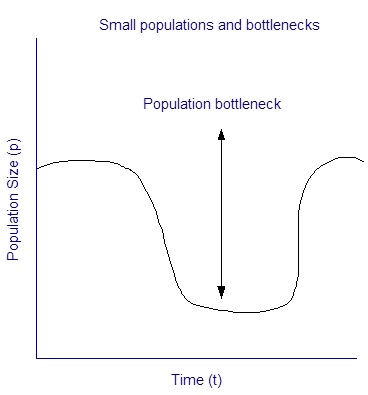
Which Species are Vulnerable?
- Species with small geographic range:
e.g. island species (Kakapo/New Zealand)
- Species with one or a few populations sizes:
e.g. White tailed Sabre-wing (Tobago & Venezuela)
- Species with small populations:
e.g. large predators or extreme specialists
- Species which have populations in decline:
- Species with low population densities:
e.g. South American macaw species
- Species which require large home ranges:
e.g. jaguar
- Species with large body size:
e.g. Siberian tiger
- Species which are poor dispersers:
e.g. Caribbean parrot species
- Seasonal migrant species
e.g. North American migrant songbirds
- Species with little genetic variability:
e.g. cheetah
- Species with specialised niche requirements
e.g. Hawaiian Drepanididae
- Species found in stable environments
e.g. tropical forest epiphytes
- Species which form temporary aggregations:
e.g. Great Auk
- Species hunted or harvested by people:
e.g. passenger pigeon
10.5 Management Tools for Endangered Species Recovery
Ex-situ Conservation
- Zoos/Aquaria & seed/gene banks
- Roles in endangered species recovery:
- Public education
- Wild population augmentation
- reintroduction source
- Sanctuary for Orphan Species
- Techniques:
- Cross-fostering
- Artificial insemination
- Embryo transfer
- Limitations:
- Cost (eg. captive elephansts cost 50 times more to manage
- than wild ones)
- Number of species: (of 274 mammal species in zoos, only
- 10% have viable populations)
- Loss of adaptive behaviors
- Not applicable to all species
ln-situ Conservation
- Includes:
- Habitat management/ecological restoration
- National Parks/Biosphere reserve
- Management of competitors & exotic species
- Management of human environment
Requires info on:
- genetic
- physiology
- behavior
- morphology
- demography
- distribution
- biotic interactions
10.6 A Few Tools for Population Performance
Monitoring game species populations can be done through the following:
Use of Hunter Provided data
~ Catch-effort techniques as a measure of population performance
~ Hunter returned data the simplest source for these data
Use of catch effort relationships in wildlife management
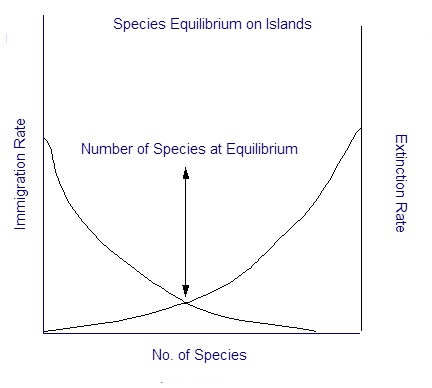
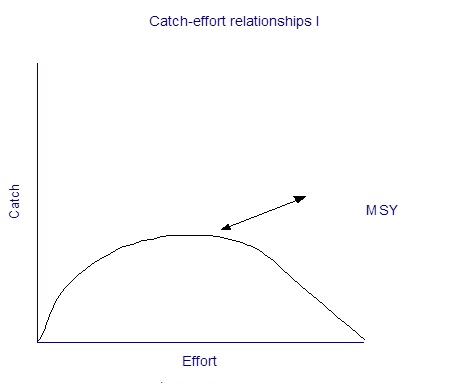
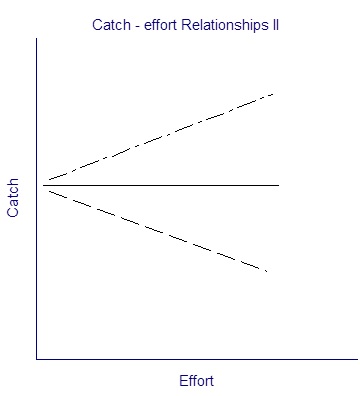
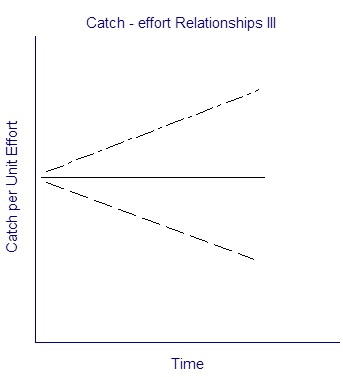
10.7 A Case Study in Game Species Management - Trinidad and Tobago
- Over-exploitation of game populations in a common theme in the process of human transformation of the landscape. Thus, in the Caribbean as much as 80 percent of the terrestrial mammals have been extirpated or driven to extinction due to human over exploitation.
- This process is being repeated again with the fauna of Trinidad and Tobago
- Catch effort analyses suggest that large-mid sized mammal populations on the islands were in steep decline over a 4 year period due to over-hunting.
- The species studied showed populations 10 to 30 times lower than one would expect (i.e. lower than K).
Management Approaches in Trinidad and Tobago
- No mechanisms for limiting "take": number of individuals harvested
- Hunting effort can only be regulated by restricting season length, no other traditional techniques can be applied (e.g. limiting the number of hunters).
- Current season length 5-6 months
- Mandatory Data-return Forms (MDF)- post 1990.
Status of Game Populations and Habitats
- Most species densities well below 0.5K
- Current harvest rates are well above the level of sustainable yield (see attached tables)
- Extent and condition of habitats in the islands remain un-quantified
Public acceptance of control measures
Questions and considerations to be asked:
1. Public support:
What methodologies can be applied with public support?
Is a public education program required?
2. Legal considerations:
Is the species a protected one? Which control techniques are legal?
3. Available techniques for harvesting:
Lethal measures:
e.g. Shooting, poisoning, snap traps
Non-Lethal measures:
e.g. relocation, taste aversion techniques, frightening screening/fencing, habitat modification, change in cultural practices
4. Cost:
Determining acceptable losses.
Cost-benefit ratio and wildlife damage control.
Are there socially acceptable levels of pest losses?
5. Timing:
When is action appropriate?
Wildlife damage control: A step-wise approach
- Problem definition
- Consideration of the ecology of the species
- Deciding on control methods
- Evaluation of success of control techniques.
- Primack, R.B. 1995. A Primer in Conservation Biology. Sinauer Associates Inc. Massachuseffs.277pp.
- Meffe, G.k., and C.R. Carroll. 1997. Principles of Conservation Biology. Sinauer Associates. Inc. Massachusetts. 729pp.
- Soule, M. E. Conservation Biology: the Science of Scarcity and diversity. Sinauer Associates. Inc. Massachusetts.
